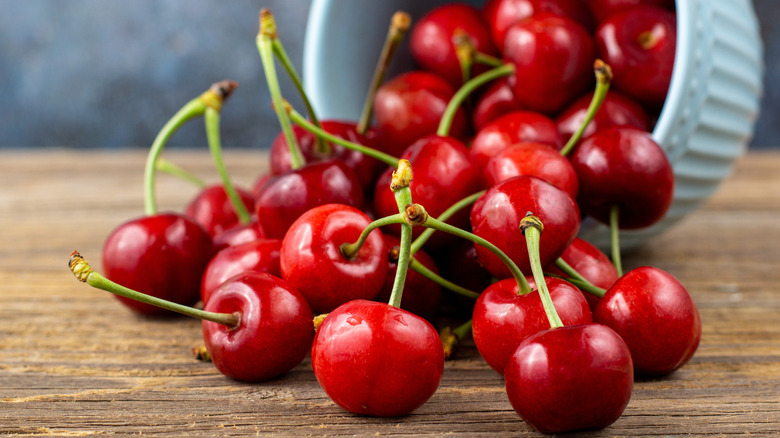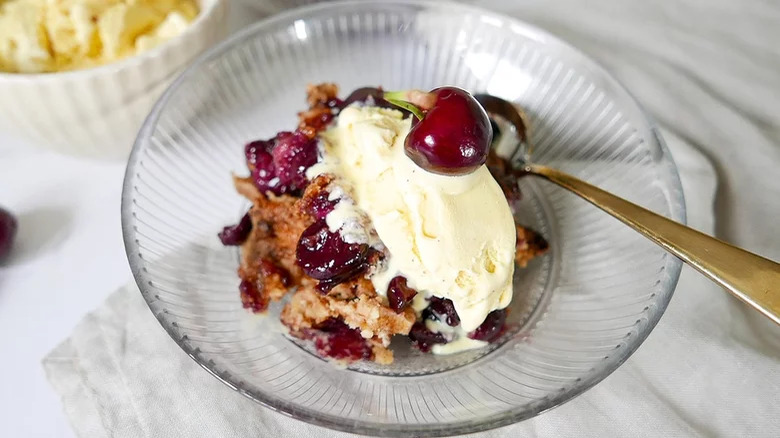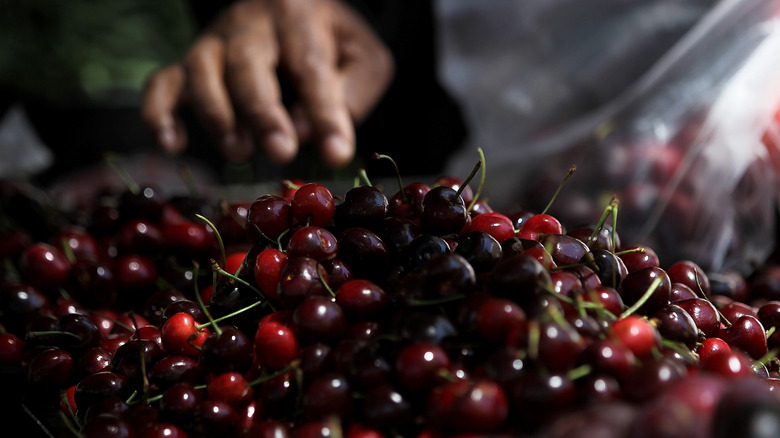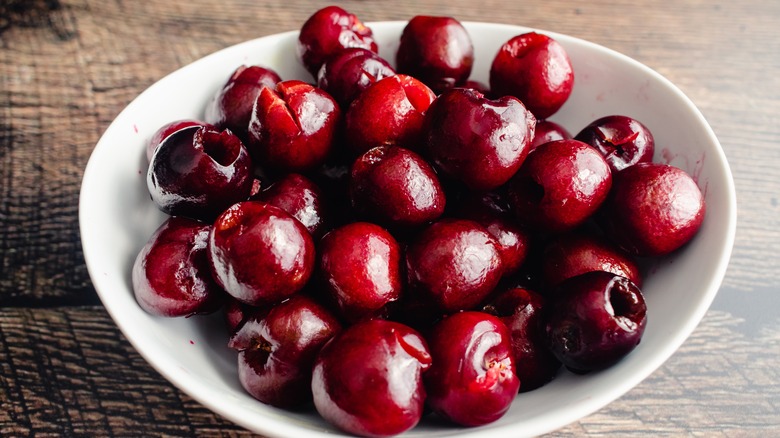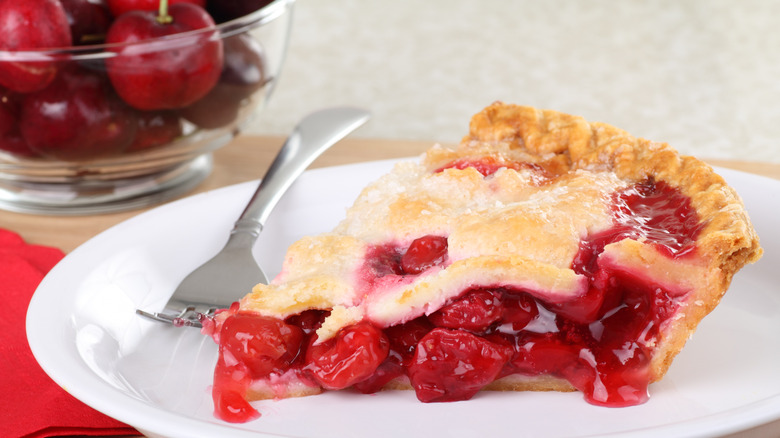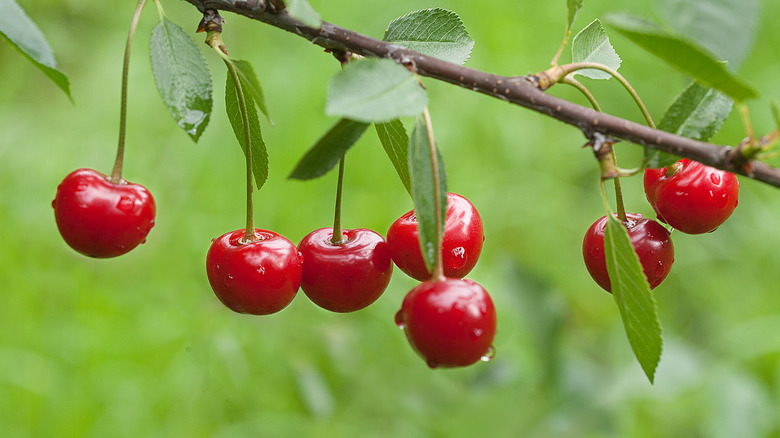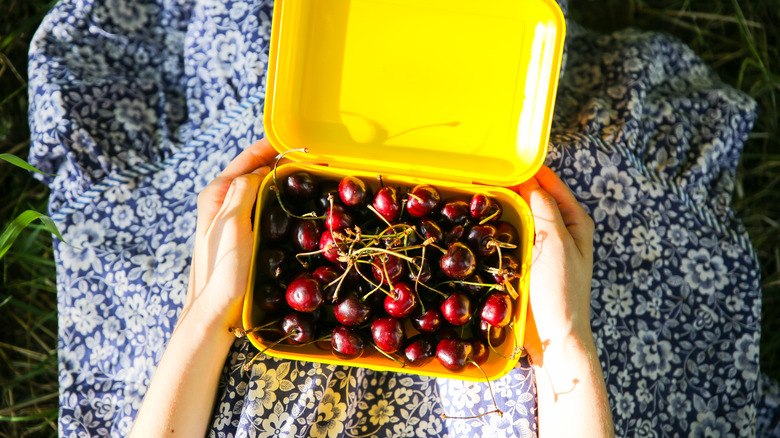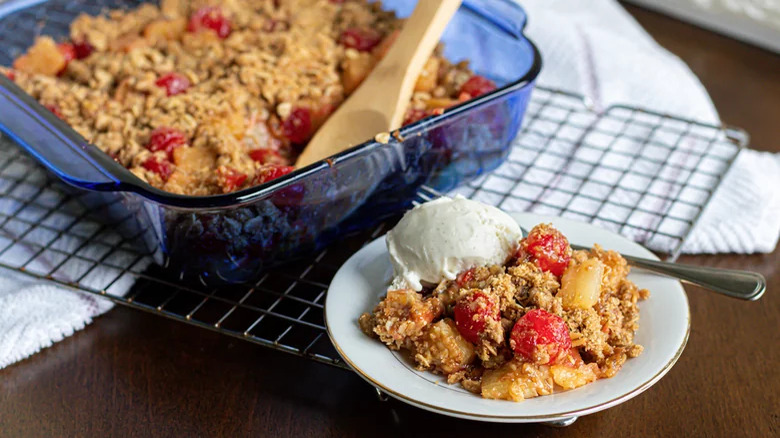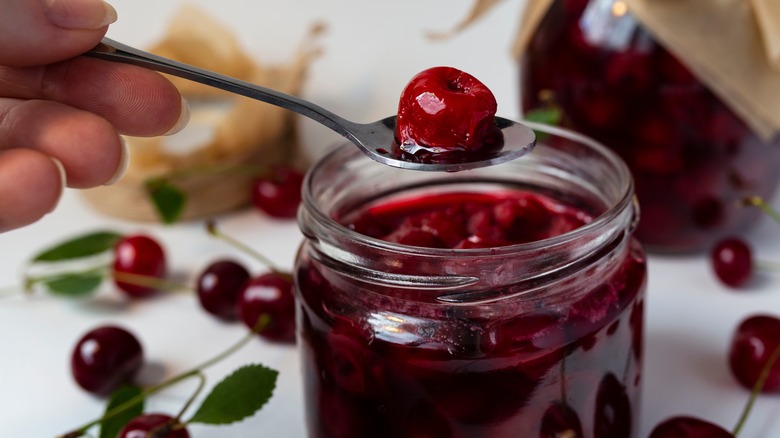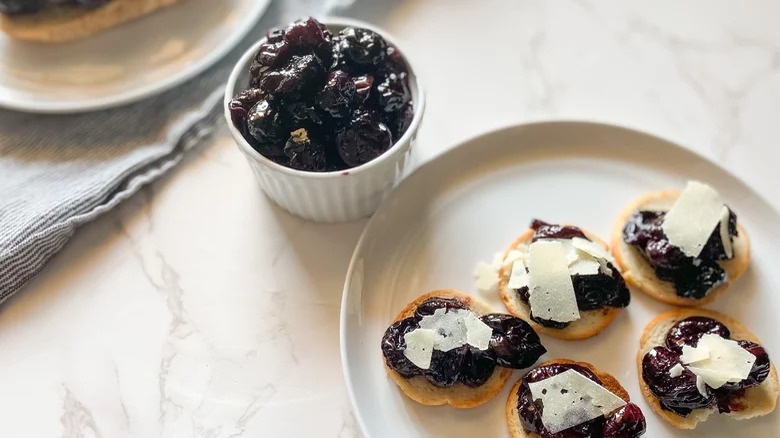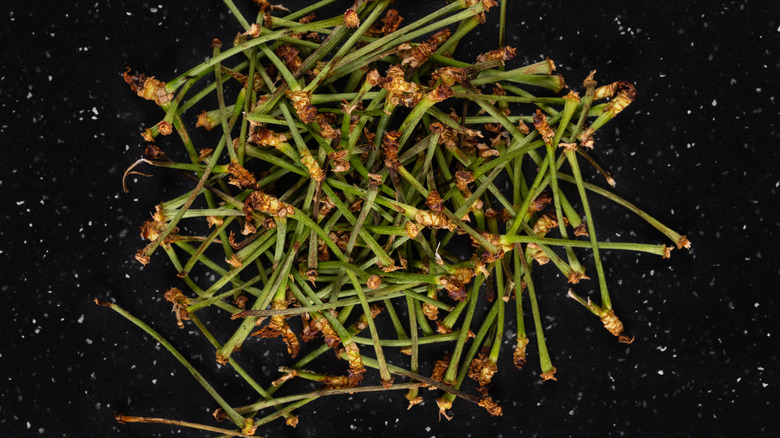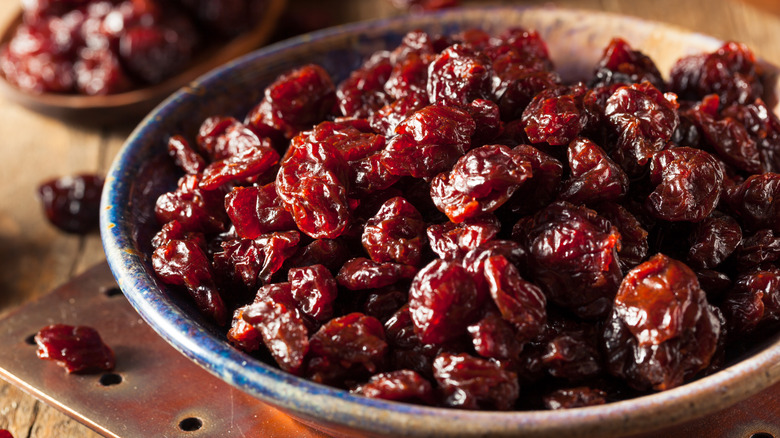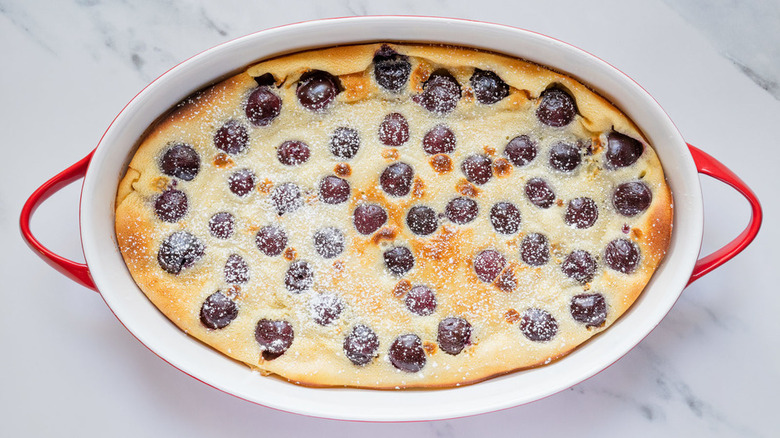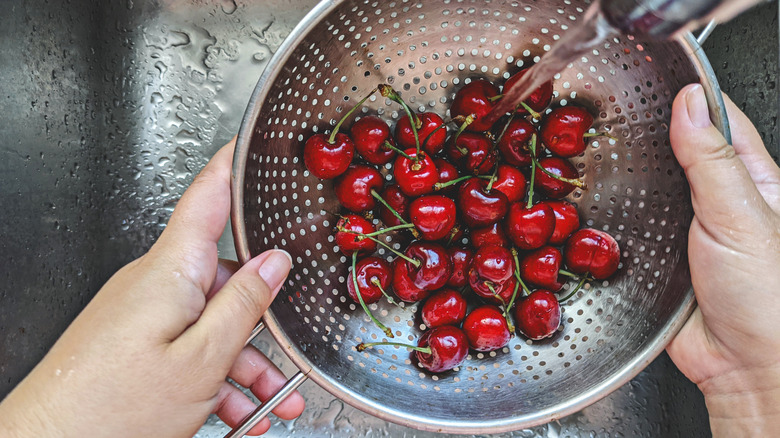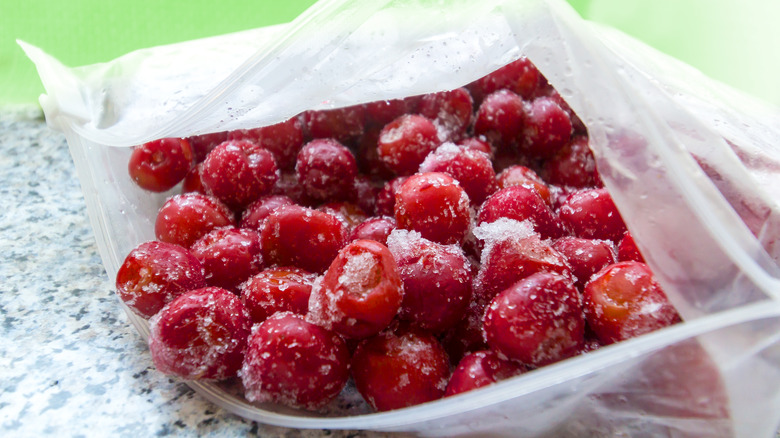Mistakes Everyone Makes With Cherries
Farmers across the nation produce a whopping 650 million pounds of sweet and sour cherries each year with the states of Washington, Oregon, and Michigan being the top growers. Folks in Michigan love their cherries so much that they celebrate every July with the National Cherry Festival in Traverse City, which is known as the "Cherry Capital of the World."
And who doesn't love cherries? There are so many varieties to choose from. But that's part of the challenge. The sweetness and tartness of cherries vary a lot, as does their texture. And that means a cherry that is well-suited for one recipe won't necessarily work with another. It's a good idea to know what types of cherries are available and what you can do with them so that you can fully enjoy cherry season, whether you're eating them fresh, making a jam, or incorporating them into one of the many decadent cherry desserts out there. To get you started, we've collected some information to help you avoid the mistakes everyone makes with cherries.
Only eating them fresh and not baking with them
One of the most delicious ways to enjoy sweet cherries is to eat them fresh. Give them a rinse, dangle them by their stems, and suck off those juicy, red orbs. All you need is the time to relax while you mindfully eat your cherries and a little dish to collect the stones. They look so good that it's tempting not to ever do anything else but eat them fresh. But it's a mistake to take such a single-minded view. If you want to appreciate the full flavor potential of cherries, you need to bake with them as well.
The end of June is when the cherry season starts. There are over a thousand varieties of the fruit, though you might only come across a few of these in the grocery store or at the farmers' market. If you're eating them fresh, you'll want to choose sweet cherries, not sour ones. But you can bake with both. When eating them fresh, you might prefer firm cherries or ones that are soft to eat. With baking, there are so many recipes to choose from. Take some time to explore and find a favorite — or two or three. One that really celebrates this juicy fruit is our cherry dump cake. All you need are some fresh cherries that've been pitted and halved, some cherry compote, butter, and cake mix.
Not looking at the stems to judge freshness
Some cherries come with long stems that are joined at the top in that iconic double cherry design. However, a box of cherries with no stems has nothing to do with their quality. It's really about how the fruit was picked. Machine-picking often removes the stems whereas hand-picking doesn't. While it's a mistake to judge a cherry by the lack of a stem, it's also an error to not check the fruits' freshness by looking at their stems when they do have them.
If a cherry stem seems a bit like a twig, as in brown, dry, and easy to break, then the fruit might be past its prime. A green stem that's in good condition — it's bendy and not snapping — denotes freshness. You can also check the cherry's skin for freshness, especially if it has no stem. The fruit should look shiny and hydrated. Warning signs are wrinkles and patches where the color has changed. If you're at a farmers' market, you can always ask for a sample to taste so you can gauge whether the sweetness and texture are just right for you.
Not pitting cherries with the right tools
For most recipes, you'll have to pit cherries by removing the stone. Nobody wants to bite into a cherry pie and come across a stone. MedicineNet points out that while swallowing one stone whole might not cause a problem if it passes through undigested, eating a few of them can cause complications, and they're certainly a big risk for children. That's because the stones have trace amounts of cyanide. Eating too many of them can be dangerous.
But pitting cherries is easier said than done. If you've ever tried to do this by hand, you already know that the fruit is easily crushed, your hands become stained, and you're left with a pulpy mess.
One option is to purchase a cherry pitter, which costs anywhere from a few bucks to more than $40 for a fancier one. You can also halve cherries with a knife and then pop the stone out. A third option involves an empty narrow-neck bottle and a chopstick. Put a whole cherry on top of the mouth of the bottle and push the chopstick down through the center of the fruit. The stone should drop out into the bottle, leaving your cherry intact on top. You don't want a lightweight bottle that might topple over — a wine bottle works well. Use a chopstick that's flatter at the end rather than pointed. A straw works too. You could also try just using a straw, without a bottle.
Not testing the tartness of cherry pie
Our mini cherry pies are made with a can of cherry filling and some rolled pie crusts. It doesn't get much easier than this. However, whether you're using fresh cherries or canned, you're making a mistake if you don't taste-test the pie filling to check how tart it is. While you don't want your pie to be too sweet, a common issue for cherry pie is that it's too sour.
The easiest way to balance tartness is by adding an extra tablespoon or two of sugar into the mixture before baking. If you'd like to enhance the sourness or if your pie is too sweet, add a teaspoon of lemon juice and some lemon zest. Cherries differ in terms of sweetness, so tasting the filling before baking is essential so you can get it right. You can add brown or white sugar, and for a mellower balancing out, you could add honey or maple syrup, or another variety of liquid sweetener such as agave syrup. However, this might make the filling too liquidy. If this happens, then you could add in some more fruit. Another option is to add in a different fruit that's going to sweeten the mixture.
Using sweet cherries in recipes meant for sour ones
Cherries vary in terms of their sweetness, and they're used in a multitude of dishes, such as this amazing recipe for brandied cherries. Which variety you use is up to you as each has its own subtle differences. Some are sweeter than others. The texture varies too. However, if a recipe calls for sour cherries, it's a mistake to use sweet ones instead. They're really not interchangeable.
Sour cherries may make you wince if you eat them fresh, but when they're baked, they sweeten up. Depending on what you're making, a sweet cherry may become too sweet once it starts to caramelize. Another difference is that sour cherries are generally not as large as the sweet ones. They're also softer, which makes them ideal for cooking when you want a jammy consistency. Not all sour cherries are the same either, so choose either a slightly acidic fruit or one that's so sour it hurts your cheeks.
Eating too many
Yes, you can have too much of a good thing. When those beautiful cherries appear, it's easy to snack on them all day long. And while they're packed with nutrients, eating too many is a mistake. That's because cherries contain salicylates, which can irritate the digestive system. If you start to hear a rumble in your stomach and feel a bit bloated and gassy while eating cherries, it's time to stop.
Cherries can have a laxative effect, too, but this isn't really due to the soluble and insoluble fiber they contain. It's caused by the sugar alcohols that are present in stone fruits. Cherries contain the sugar alcohol sorbitol, which can really stimulate the gastrointestinal tract. You might also have an intolerance to this substance or to cherries in general, especially if you regularly have digestive issues. A recommended serving, according to Livestrong, is 21 cherries. And remember, don't eat the stones at all.
Not matching the right cherry variety with the right recipe
A lot of recipes call for canned cherry filling, whereas others are best when made with fresh cherries that have been pitted. There are also dishes and desserts that you can make with dried cherries or even frozen ones, such as our 15-minute cherry upside-down cake.
But the varieties of cherries are important, too. Black cherries, which are a deep purple in color, are plump and sweet and pair well with yogurt. Vibrant red Bing cherries are cute and more heart-shaped, promising a sweetness with a touch of tartness that makes them perfect for pies. Santina cherries are also heart-shaped and sweet. Rainier cherries from the U.S. are yellow and red and are delicious in salads. Also grown in the U.S., Chelan cherries are subtly sweet. Morello and Montmorency cherries are sour and better cooked than consumed fresh. Canadian Lapins are red and sweet, whereas Queen (Royal) Anne cherries are often used to make maraschino cherries. These are the candied cherries you get on the top of ice cream sundaes — they wouldn't be suitable for a cherry pie. However, you can find some recipes that use them, such as our pineapple cherry crisp, which balances the super sweetness of the sweetened cherries and the sourness of the pineapple.
Making runny cherry jam
You wake up on a summer morning, make some tea, and fix yourself some toast with homemade cherry jam. Sounds idyllic, doesn't it? What's less sunny is trying to spread a jam that's dripping off the knife and running off your toast. The sweet and sour taste notes of cherries make for perfect jams. However, in relation to other fruits, cherries don't have a lot of pectin in them. This is what helps a jam to set. One of the biggest mistakes everyone makes with cherries when they're making jam is not setting it enough. The result is a runny, sticky mess.
You might find that the best solution is to change up a general jam recipe. Instead of boiling cherries, sugar, and added pectin so much that the flavor gets lost, try adjusting how much sugar you add. More sugar is going to produce a firmer jam. However, this has to be weighed against taste as you want jam that's not overly sweet. Likewise, lemon juice can help with the setting, but you don't want to make your jam too sour. Other tips on a forum from Allotment Gardening include mixing the pectin powder with sugar before adding it to the cherries so that it dissolves better into the jam. You could add other fruits such as berries or apples that have a higher amount of pectin. However, this will influence the final taste of the jam, depending on how much you've added.
Only using cherries in sweet dishes
It's not a mistake to use cherries in sweet dishes. There's nothing more delicious during the summer than a sweet cherry something with a tang of tartness. Cherries are delicious with pastry, cream, and yogurt. They're also amazing and decadently fruity in our 3-ingredient chocolate cherry cake. What is an error, though, is to only equate using cherries with desserts and sweet dishes. They're also great to pair with savory ingredients.
Our spicy cherry chutney is made with balsamic vinegar, red chili flakes, and diced jalapeño. The sweetness of the pitted cherries and brown sugar balances the acidity and heat to create a fruity relish with a sweet bite. It's perfect when served on crostini with a slither of cheese on top. Cherries are great with meat too. Try making a thyme, cherry, and balsamic vinegar topping for pork chops. What about incorporating roasted cherries into a salad or making a salsa? Top a pizza with the fruit or make goat cheese tarts with a pop of cherry red color and taste. All that holds you back from using cherries to make appetizers, sides, and entrees is a little imagination and experimentation.
Throwing away the stem
After you've munched your way through some fresh cherries, be sure to save your stems. It's a mistake to think there's nothing you can do with them. Before tossing them away, consider making cherry syrup. If you love nothing better than a few shaken and stirred cocktails at home, then this is a recipe to extend your bar ingredients. Cherry stems have a lot of goodness in them. They have anti-inflammatory properties (as do cherries). The stems are also full of oils and potassium salts and are detoxifying. The nutrients found in stems, and the fruit as well, are renowned as being beneficial in relation to a variety of ailments, from cystitis to rheumatoid arthritis. Bet you can't wait to make something with them now.
To make the syrup, put the cherry stems in a dehydrator or in an oven set at 170-210 degrees Fahrenheit. Once the stems are brown and dry, grind them up. Simmer 30 ground stems for 15 minutes in about 2 cups of boiling water. The liquid will reduce and turn cherry red. Strain out any stems, then combine equal amounts of sugar and the reduced stem water while it's still hot to create the syrup. Adding a small amount of this syrup to mocktails and cocktails will add a little color, but the main impact is the flavor. Try this with rum and Angostura bitters for an Old Fashioned with a cherry stem twist.
Not drying cherries to preserve them
Letting cherries rot in the fridge is a no-no, so if you've got an abundance of them, find a good way to preserve them. If you really want them to last, then it's a mistake not to consider drying them. Dried cherries are a tasty and nutritious snack and might stop you from reaching for junk food between meals. Dried cherries taste sweet with a sour burst and are good for you too. They're also ideal as an ingredient for recipes. Make our cherry pecan bread pudding with dried cherries and staple ingredients such as milk, eggs, and bread. It's great as a dessert or even for breakfast.
You can dry cherries in the oven at 175-200 degrees Fahrenheit for six to nine hours. Bake them whole or halved with the cut side facing up. Lay them out with space between them. If you use a dehydrator, it's going to take twice as long. If you've got a few days, you could dry them in the sun on a wire rack over a tray. Cover them while they're outside, and don't leave them out overnight. When done, dried cherries should be bendable with a rubbery texture.
Not seeking out interesting cherry recipes
If you were put on the spot and asked to come up with a few different cherry recipe ideas, then you'd probably come up with the same standards that most other people do. Most everyone thinks of cherry pie and cherries on top of an ice cream sundae or a Black Forest cake. Cherries are often added to scones and tea loaves as well. However, not seeking out interesting cherry recipes is a mistake. There are so many.
Unless you've made it before or eaten it in the past, you're less likely to come up with clafoutis. In fact, you'll be forgiven if you don't know what this even is. It's a cakey, custardy style dessert from France. As the batter bakes, the cherries pop up, making the final result look stylishly delicious. Basically, it's a pancake batter that you bake in the oven with fresh cherries and serve warm dusted with powdered sugar.
Storing them washed
Juicy purple and red-hued cherries are big and bold. They're beautifully round and sumptuously succulent. You can eat them as they are, dry them, bake them, and boil them. However, they're not as robust as you might think. They're soft and a little fragile, so they squash easily and don't last long once they're ripe. If you've ever gotten home from the market with a paper bag full of cherries, a few have probably got smashed in transit. No doubt they didn't last long enough to spoil. If you're not eating them straightaway, though, you need to store them in the right way.
Cherries need to be refrigerated unless you're preserving them in a different way. Put them in the chiller, and you might have a couple of weeks to use them up. Sour cherries are best eaten on the same day, though. That's if you don't make a big mistake by washing them first. By all means, give cherries a gentle rinse right before eating. But don't wet them and then refrigerate them because the delicate skins might break. Keep your cherries dry, and don't let them touch any cold parts of the fridge directly for the same reason.
Freezing in one way only
If you know anything about storing cherries, you'll know that a great way to keep them fresh longer is to freeze them. This is particularly handy if it's coming to the end of the season, and you want to save some cherries to create recipes later. What is a mistake, though, is not recognizing the different ways that you can freeze cherries. The key to choosing which way is based on how you're going to use the cherries.
You can simply put the fruit in freezer-safe tubs or bags with the air pressed out beforehand. If you want, you can add ⅔ cup of sugar to a quart of sour cherries and half that amount of sugar to sweet ones before putting them in the freezer. Whether the cherries are sweetened or not, this is an ideal way for freezing cherries to cook with. You should freeze cherries individually on a sheet for smoothies or garnishes. You can always store them together after they're frozen. Meanwhile, for cherries in desserts that aren't cooked, store the fruit in syrup before freezing. For a light syrup combine a ratio of 1:4 sugar and water. Add the cherries to the syrup once it's cold and then freeze.
